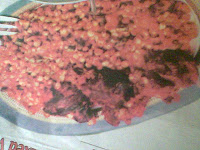
Ingredients:
1kg of meat
1 medium sized onion
1 tin of tomato puree
8 cups of fresh corn (maize)
1 teaspoon of fresh pepper (ground)
6 cooking spoons of vegetable oil
Salt to taste
3 fresh tomatoes
2 medium bunches of lettuce
2 medium size carrots
2 litres of water
Salt to taste
1 cup of green peas
Seasoning (1 teaspoon each of curry and thyme)
2 knorr chicken cubes
Method:
1 medium sized onion
1 tin of tomato puree
8 cups of fresh corn (maize)
1 teaspoon of fresh pepper (ground)
6 cooking spoons of vegetable oil
Salt to taste
3 fresh tomatoes
2 medium bunches of lettuce
2 medium size carrots
2 litres of water
Salt to taste
1 cup of green peas
Seasoning (1 teaspoon each of curry and thyme)
2 knorr chicken cubes
Method:
Rinse the lettuce, carrots, onions and tomatoes in clean water add some salt into the water to purify them of any germs on them. Chop the lettuce; grate the carrots, onion and tomatoes separately into four different plates and set aside. Cut the meat into sizes that can be served, wash it thoroughly, pour the meat into a pot, add some water, slice in some onions, add the 1 teaspoon of curry and thyme, 1 cube of knorr chicken, salt and boil the meat until it becomes soft, set the meat stock aside and pour some vegetable oil into the frying pan. When the oil becomes hot, fry the boiled meat in the hot oil until both sides of the meat becomes golden brown. Wash the corn (maize), pour the washed corn (maize) into the meat stock and boil it until it becomes very soft. Fry the tomato puree, slice some onions into the tomato puree add 1 teaspoon pepper, 1 cube of knorr chicken for about 7 minutes. Pour the fried tomato puree into the pot containing corn (maize), pour the green peas and allow it to simmer for 15 minutes, shake the pot from time to time, taste for salt. The corn (maize)jollof is now ready to be served which is garnished with the chopped lettuce, grated onions, carrots and tomatoes.





.png)
